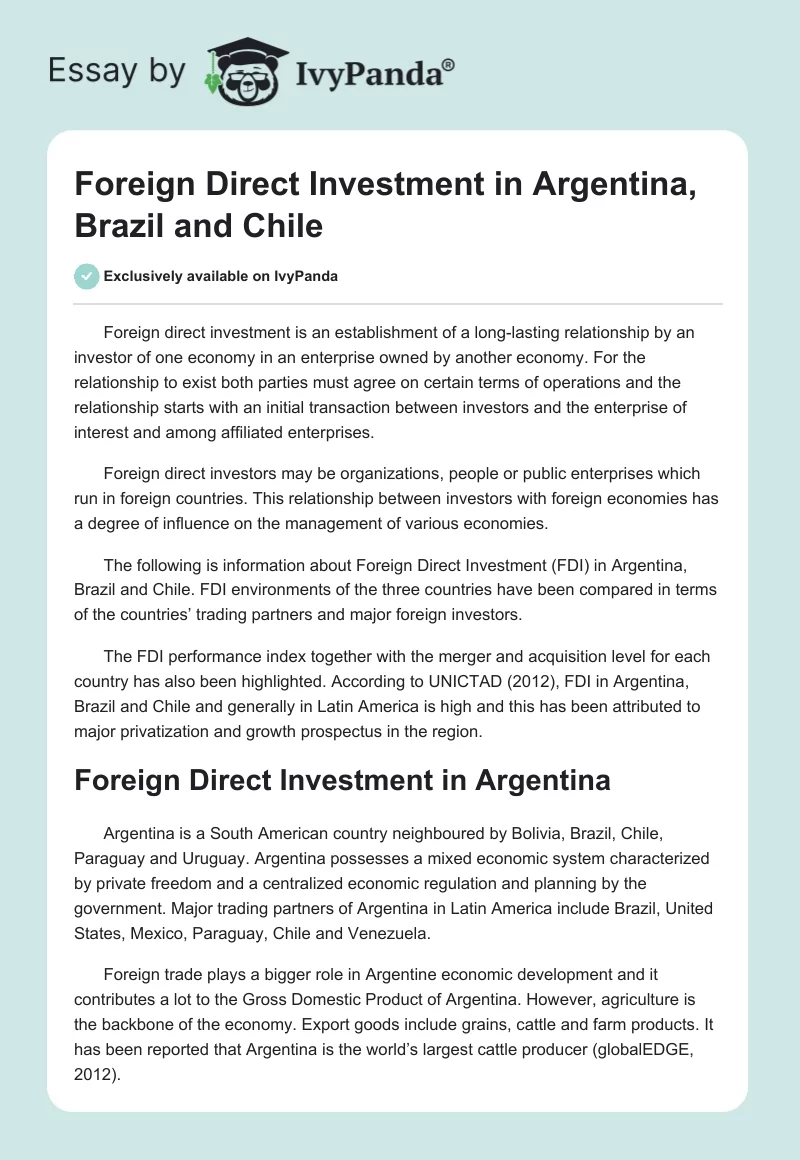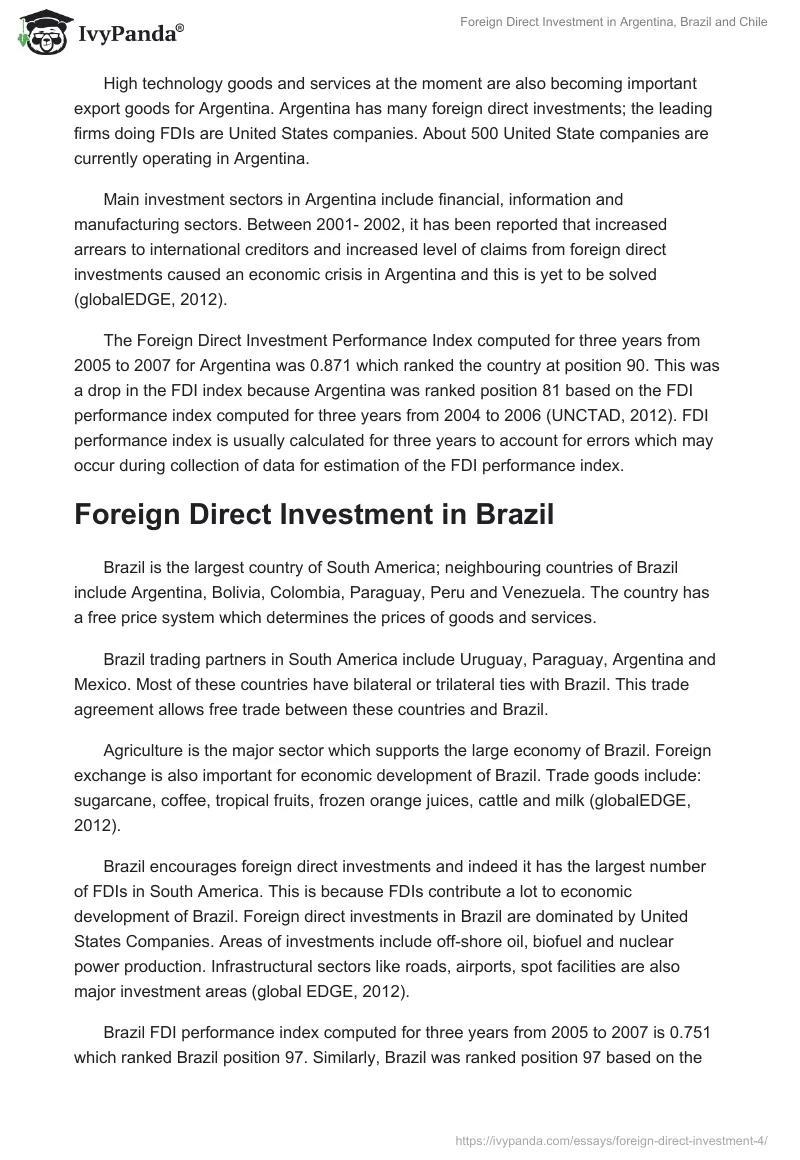Foreign direct investment is an establishment of a long-lasting relationship by an investor of one economy in an enterprise owned by another economy. For the relationship to exist both parties must agree on certain terms of operations and the relationship starts with an initial transaction between investors and the enterprise of interest and among affiliated enterprises.
Foreign direct investors may be organizations, people or public enterprises which run in foreign countries. This relationship between investors with foreign economies has a degree of influence on the management of various economies.
The following is information about Foreign Direct Investment (FDI) in Argentina, Brazil and Chile. FDI environments of the three countries have been compared in terms of the countries’ trading partners and major foreign investors.
The FDI performance index together with the merger and acquisition level for each country has also been highlighted. According to UNICTAD (2012), FDI in Argentina, Brazil and Chile and generally in Latin America is high and this has been attributed to major privatization and growth prospectus in the region.
Foreign Direct Investment in Argentina
Argentina is a South American country neighboured by Bolivia, Brazil, Chile, Paraguay and Uruguay. Argentina possesses a mixed economic system characterized by private freedom and a centralized economic regulation and planning by the government. Major trading partners of Argentina in Latin America include Brazil, United States, Mexico, Paraguay, Chile and Venezuela.
Foreign trade plays a bigger role in Argentine economic development and it contributes a lot to the Gross Domestic Product of Argentina. However, agriculture is the backbone of the economy. Export goods include grains, cattle and farm products. It has been reported that Argentina is the world’s largest cattle producer (globalEDGE, 2012).
High technology goods and services at the moment are also becoming important export goods for Argentina. Argentina has many foreign direct investments; the leading firms doing FDIs are United States companies. About 500 United State companies are currently operating in Argentina.
Main investment sectors in Argentina include financial, information and manufacturing sectors. Between 2001- 2002, it has been reported that increased arrears to international creditors and increased level of claims from foreign direct investments caused an economic crisis in Argentina and this is yet to be solved (globalEDGE, 2012).
The Foreign Direct Investment Performance Index computed for three years from 2005 to 2007 for Argentina was 0.871 which ranked the country at position 90. This was a drop in the FDI index because Argentina was ranked position 81 based on the FDI performance index computed for three years from 2004 to 2006 (UNCTAD, 2012). FDI performance index is usually calculated for three years to account for errors which may occur during collection of data for estimation of the FDI performance index.
Foreign Direct Investment in Brazil
Brazil is the largest country of South America; neighbouring countries of Brazil include Argentina, Bolivia, Colombia, Paraguay, Peru and Venezuela. The country has a free price system which determines the prices of goods and services.
Brazil trading partners in South America include Uruguay, Paraguay, Argentina and Mexico. Most of these countries have bilateral or trilateral ties with Brazil. This trade agreement allows free trade between these countries and Brazil.
Agriculture is the major sector which supports the large economy of Brazil. Foreign exchange is also important for economic development of Brazil. Trade goods include: sugarcane, coffee, tropical fruits, frozen orange juices, cattle and milk (globalEDGE, 2012).
Brazil encourages foreign direct investments and indeed it has the largest number of FDIs in South America. This is because FDIs contribute a lot to economic development of Brazil. Foreign direct investments in Brazil are dominated by United States Companies. Areas of investments include off-shore oil, biofuel and nuclear power production. Infrastructural sectors like roads, airports, spot facilities are also major investment areas (global EDGE, 2012).
Brazil FDI performance index computed for three years from 2005 to 2007 is 0.751 which ranked Brazil position 97. Similarly, Brazil was ranked position 97 based on the FDI performance index computed for 2004 to 2006(UNICTAD, 2012). According to 2012 ranking, Brazil has been ranked position three with a FDI performance index of 1.60 (ATKearny, 2012).
Foreign Direct Investment in Chile
Chile is a South American Country neighbouring Argentina, Bolivia and Peru. Chile has a republican government with a free price system which determines the prices of goods and services. The country has trade agreements with sixty countries. These free trade agreements promote foreign trade between Chile and the countries involved.
Trading partners of Chile include United States, Brazil and Argentina. Chile has a high annual economic growth which ranges around 6%. Main exports goods include copper. Indeed the country has the largest copper producing firm (globalEDGE, 2012). On the other hand, Forestry and wood products, wine products and fish meals are also important trade goods in Chile.
The country has welcomed a lot of foreign investors recently. One reason which has attracted a lot of foreign investors to Chile is equal treatment of foreign investors and Chilean investors. This equal treatment of investors in Chile together with simple and transparent registration has increased the number of FDIs in Chile. In addition, foreign director investors in Chile are able to make use of foreign exchange markets where they reap a lot of benefits.
According to UNICTAD (2012), Chile was ranked position 37, based on the FDI performance index calculated for three years from 2005 to 2007. On the other hand, the FDI performance index computed for 2004 to 2006 which was slightly higher was 2.686 and it ranked Chile position 35.
Foreign Direct Investment index is an important tool because it provides information current and future foreign investments. The index assesses the effects of economic, political and regulatory changes on foreign direct investment in various parts of the world.
The level of merger and acquisition activity has been on the increase in Latin America particularly in Argentina, Brazil and Chile (UNCTAD, 2004). North America companies, European companies and other companies which are prominent in the region have been highly active in acquiring other firms and merging with other firms. For instance Spanish largest company, Repsol has merged with various Argentine companies where it has made huge investments (UNCTAD, 2012).
Six Spanish companies are also operating in Argentina and are merging or acquiring various Argentine companies. With merging and acquisition, most companies increase their production output and their net sales and this leads to high profits. Due to this, we have cross-border acquisitions and merging where firms are willing to go beyond their countries in which they run to merge and acquire other firms.
References
ATkearny. (2012). Foreign Direct Investment (FDI) Confidence Index. Web.
Global EDGE. (2012).Global Insights. Michigan State University. Web.
UNCTAD. (2004). Latin America and the Caribbean.United Nations Conference for Trade and Development.9, 1-599. Web.
UNCTAD. (2012). Inward FDI Performance Index 2005-2007. United Nations Conference for Trade and Development. Web.


